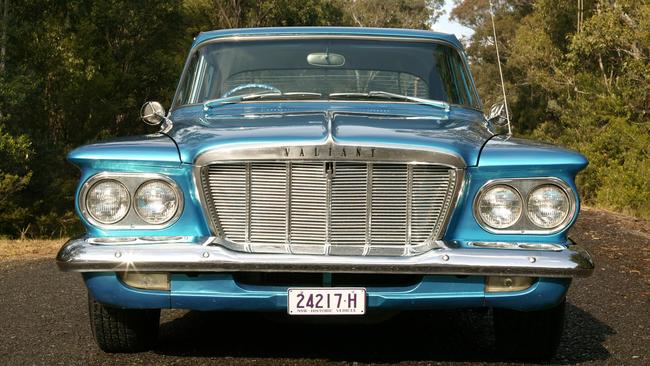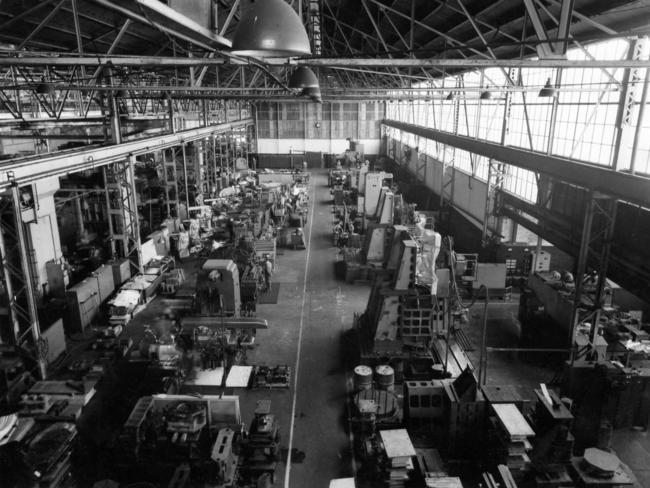Remember when Chryslers were made in Adelaide?
ONCE, there was more to the Adelaide car industry than just Holden. And before you say Mitsubishi — what about Chrysler? Here’s a look back at the company’s impact, and how in the 1960s, everyone had a Valiant.

SA News
Don't miss out on the headlines from SA News. Followed categories will be added to My News.
- Adelaide’s ‘Woodstock’: The three-day Myponga Pop Festival in 1971
- Derek Jolly and The Futuro, North Adelaide’s Flying Saucer House
WHENEVER I think back to those halcyon years of my youth, I remember how the cars we drove, and those we dreamt of owning, played such an important part.
There were three local manufacturers back in the day — Holden, Ford and Chrysler.
Much has been written and discussed about the first two but Chrysler, which was taken over by Mitsubishi in 1980, and its role in those exciting years, is perhaps sometimes overshadowed.
The car I’ve always lusted for is the Chrysler Valiant R Series, the first Valiant to be released on the Australian market, in 1962. Sheer poetry in motion.
Chrysler had a long association and history with Adelaide that goes back to 1884 when a blacksmith named Tobias Richards started coach-building company T.J. Richards in Mitcham.
Business was brisk and in 1900 Tobias expanded and moved his small company to Hindmarsh Square where he was shortly joined by his three sons.
In 1912, the motor car industry was starting to boom and TJ and the boys started building car bodies.

In the early 1920s they moved production again to larger premises on the corner of Anzac Highway (then known as Bay Rd) and Leader St at Keswick (now occupied by LeCornus).
Wikipedia lists the various car bodies being made by the company at the time as Bianchi, Citroën, Fiat, Maxwell, Oakland, Overland, Armstrong-Siddeley, Austin, Huppmobile, Berliet, Durant, Amilcar, Rover and Rolls-Royce.
Several years later, after opening another factory in Mile End, the company also began making bodies for the American Chrysler Corporation for models such as Chrysler, Dodge, DeSoto and Plymouth.
When war broke out in the late ’30s, T J Richards and Sons acquired several government defence contracts, and the company and factory survived those years by retooling for weapons and ammunition manufacturing.


After the war, the firm returned to motor vehicle production, mainly creating car bodies for Chrysler and then in 1951 the Chrysler Corporation from America bought a controlling interest in T J Richards and Sons and changed the name to Chrysler Australia Ltd.
Those post-war years were good to the car industry in Australia. Along with Holden and Ford, Chrysler became one of the nation’s leading car manufacturers.
Chrysler in America was keen to further develop their share of the local market and in 1961 devised a grand plan to create an all-Australian six-cylinder model to be known as the Chrysler Valiant.
To get the car to market as soon as possible it was decided to fully import the first 1000 vehicles direct from the US and assemble them at the Mile End plant.
The new Chrysler R Series Valiant hit the showroom floor in early 1962 and the response from the public was immediate and overwhelming. It was love at first sight, and within days of its release the model had completely sold out.

The Keswick and Mile End plants by that time were in full production of the follow-up model, the S Series, and in the year of 1962 Chrysler Australia assembled more than 10,000 cars, all snapped up within days of reaching the showroom.
Registration figures from that year show an increase in production of almost 150 per cent by Chrysler and still demand was not satisfied.
Although the Valiant was more expensive than either the Holden or Ford models at that time, it was more powerful and soon gained the reputation as an excellent family car and a good performer.

Record sales of the new Chrysler Valiant continued in 1963 and led to plans for a major expansion program with a new manufacturing plant at Tonsley Park.
Early that year the all-Australian Valiant, the AP5, was released. Built for the more rugged local conditions, the new model again found favour with car buyers and continued to build the brand’s loyal following.
The new assembly line plant was opened with much fanfare by then-Prime Minister Bob Menzies in October 1964 and Chrysler announced a planned $36 million expansion program had been doubled to $72 million.
By 1967 the company had climbed to third place in the national sales chart, and could claim almost 15 per cent of the new vehicle market in Australia. This led yet again to further expansion with a new motor assembly plant opened at Lonsdale.

The 1960s were wonderful years for Chrysler Australia in Adelaide. It seemed the company could do no wrong with continued high demand for their cars and regular increases in production. In 1969 the company celebrated its biggest and best year on record with a record number of Valiants sold and record profits.
The future looked bright, but the 1970s brought with it troubled times — including a fuel crisis, quality control problems, unpopular models and mistakes that saw the Valiant lose sales.
Despite the release of the Charger sports coupe, the fastest-accelerating Australian production car made, the Valiant started to lose ground against its main competitors of Holden and Ford.
This, combined with the problems being faced by its parent company in the US, created setbacks in financing a retool for new models.

That soon led to a stagnation of new design and innovation, something on which the company had built its reputation and soon new car buyers began to look at other imported and local models.
At the same time Chrysler in the US had bought into the Japanese company Mitsubishi and in the early 70s it was decided to rebadge the Mitsubishi Galant as a small Valiant and launch an assault on the growing small-car market in Australia. It worked, and Chrysler was soon again in expansion mode, this time to manufacture another Mitsubishi model, the Sigma.
By then the Valiant sales numbers were well down but small-car sales had picked up and by 1978 the Chrysler Sigma was named the biggest-selling four-cylinder vehicle on the market. But it was all too late.


In America the troubled Chrysler Corporation was on the brink of bankruptcy and about to be closed when former Ford CEO Lee Iacocca took the reins and set in motion some drastic measures to save it, including selling off all overseas interests, including Chrysler Australia.
Mitsubishi bought Chrysler Australia in October 1980 and the name was changed to Mitsubishi Motors Australia Limited.
The last Chrysler Valiant rolled off the assembly line in August 1981.



